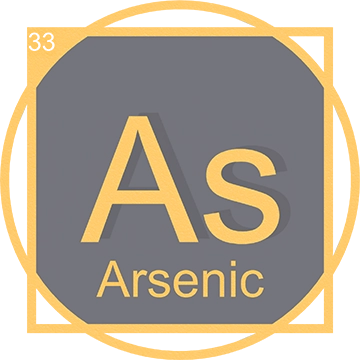Arsenic (As): Navigating Its Complex World
Discover the intriguing aspects of Arsenic, from its historical discovery to its modern applications and environmental impact.
The Discovery of Arsenic
The history of Arsenic dates back to ancient times, with its known existence predating the common era. However, it was first scientifically recognized as an element by Albertus Magnus, a German philosopher and alchemist, in the 13th century. This discovery marked a significant milestone in the study of chemistry, offering insights into the properties and potentials of elements in the periodic table.
Arsenic in the Periodic Table

Positioned in group 15 of the periodic table, Arsenic holds a place among the metalloids, elements that possess both metallic and non-metallic properties. This dual nature facilitates its versatility in various applications, from strengthening alloys to combating pests, and its pivotal role in semiconductor technology.
The Role of Arsenic in Science and Technology
Arsenic's contributions to science and technology are manifold. In the realm of semiconductor technology, Arsenic is invaluable in the manufacture of gallium arsenide, a compound critical for making LEDs, lasers, and solar cells. Moreover, its historical use as a pesticide underscores the importance of understanding its environmental impact and the need for responsible management of toxic elements.

Understanding Arsenic's Environmental Impact
The story of Arsenic is not without its dark sides. Its toxicity has been a concern throughout history, with implications for water quality, soil health, and food safety. Recent advances in environmental science have shed light on methods to mitigate Arsenic's harmful effects, emphasizing the importance of monitoring and managing its presence in the environment.
The Future of Arsenic Research

As research continues, the potential for new and innovative uses of Arsenic in technology and medicine expands. Scientists are exploring its applications in treating certain types of cancer, showcasing the element's potential to contribute positively to human health. The ongoing study of Arsenic, balancing its benefits against its risks, exemplifies the complex relationship humanity has with the elements of the periodic table.
Join us in exploring the multifaceted world of Arsenic and its contributions to science, technology, and environmental stewardship. For more insights into Arsenic and other elements, stay tuned to our website.
How Arsenic Is Produced

Arsenic is primarily obtained as a byproduct of the smelting process of various metal ores, including copper, gold, and lead. Mines that produce these metals often find Arsenic in the form of arsenopyrite, a common Arsenic mineral. Notable locations for these mining activities include China, Chile, and Morocco, where Arsenic is extracted alongside these valuable metals, reflecting its intertwined existence with the mining industry.
A typical mine you can find Arsenopyrite in on the Kishnica Mine in Kosovo.
Modern Applications of Arsenic
In today's world, Arsenic remains a critical element in a variety of applications. Its use in semiconductor technology, particularly in the creation of gallium arsenide (GaAs) chips for mobile phones and other electronic devices, showcases its importance in the tech industry. Arsenic compounds are also used in the preservation of wood and as part of lead alloys for car batteries, indicating its widespread utility across different sectors.
The Future of Arsenic Research
The dual nature of Arsenic as both a toxin and a valuable resource continues to drive research into its safe and innovative use. In the field of medicine, ongoing studies investigate the potential of arsenic trioxide in treating certain types of leukemia, offering hope for new cancer therapies. Environmental research also focuses on developing more effective methods for Arsenic removal from drinking water, ensuring safer water supplies. As we advance, the future of Arsenic research promises to harness its properties for beneficial uses while minimizing its environmental and health impacts.













